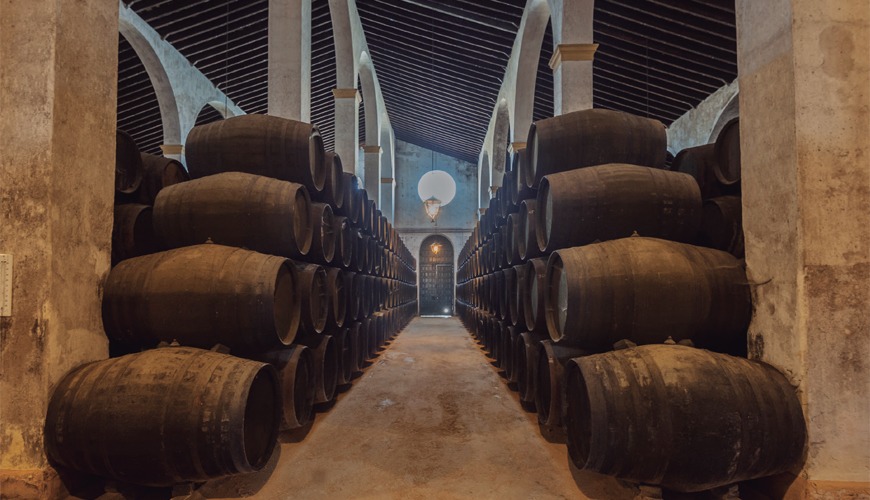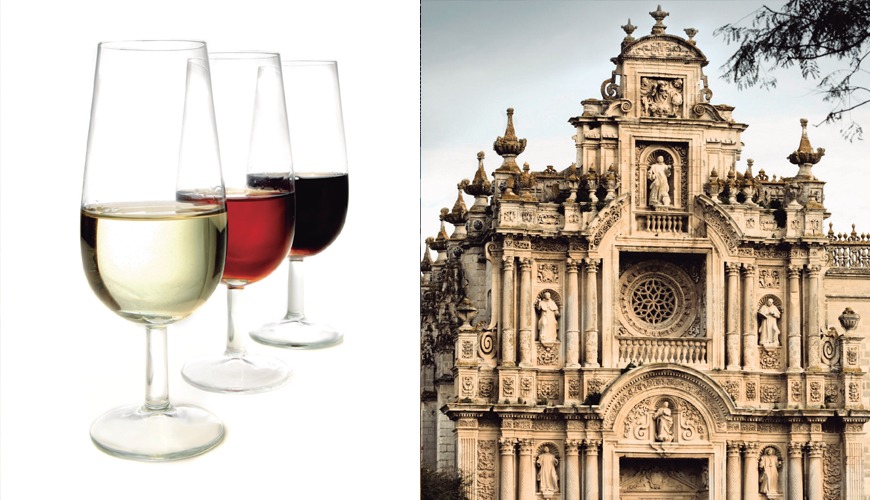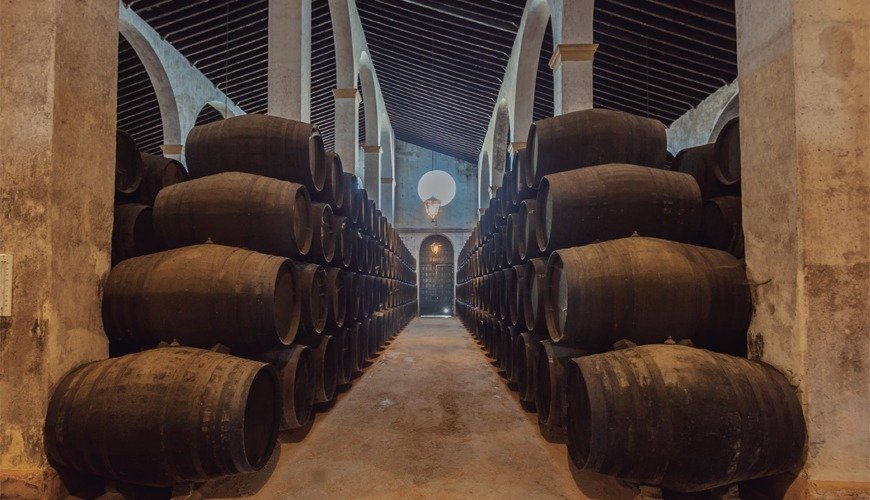“Sherry has so many different styles it’s hard not to find one that fits your personality and taste.”
It’s a veritably tasty tipple that wine connoisseurs often regard as under-appreciated. But in bustling bars worldwide sherry has experienced somewhat of a renaissance over the last decade. Once seen as the preserve of older drinkers, this fortified wine is back with a bang thanks to a younger generation discovering its charm.

Nevertheless, in the Andalusian city of Jerez the sweet stuff has never gone out of fashion, with bars full of sherry aficionados dissolving into lip-licking rapture at the mere sight of a glass of fino. And much like the belly of a seasoned sherry drinker, the economy of Jerez has grown fat from the wine industry over the centuries, having exported it to sherry loving countries such as the UK . It’s a well-known fact that when the drink was first exported to England in the 13th century, the name Jerez was anglicised to become sherry.
But the Brits addiction to the drink was perhaps cemented in 1587 when Sir Francis Drake ransacked the port of Cádiz, taking 3,000 barrels of the stuff back to Britain. It’s little wonder therefore, that many of the Jerez cellars were founded by British families. As for its popularity in Spain, this goes hand in hand with its diverse range of flavours.
“The beauty about sherry is that it pairs elegantly with difficult foods,” said Kelly Kannisto, co-founder of Jerez based TrippyVines.
“Fino style wines obviously pair beautifully with seafood, some can even handle spicy food - Amontillado with Szechuan pepper or curry, for example - and they all tend to work beautifully with savoury food. They can also pair well with difficult vegetables such as asparagus and artichokes, or with richer meats such as beef or lamb.” She added: “Sherry is not just your Granny´s drink any more. In fact, sherry has so many different styles it’s hard not to find one that fits your personality and taste.”
Arguably Tio Pepe is the town’s most famous producer, but there are dozens of varieties that range from very dry, to very sweet in flavour. To help protect its uniqueness, in Europe sherry has been given Protected Designation of Origin status, just like champagne. Therefore, under Spanish law, all wine labelled as sherry must legally come from the Sherry Triangle – an area in the province of Cádiz between Jerez de la Frontera, Sanlúcar de Barrameda and El Puerto de Santa María.
Jerez’s passion for viniculture dates back to when wine making was introduced to the Iberian Peninsula by the Phoenicians in 1100BC, a practice continued by the Romans from 200BC. Even Islamic forces, who are traditionally opposed to alcohol, did not kill the wine trade when they arrived in 711 AD. The inhabitants of Jerez appealed against the vineyards destruction on the grounds that they also produced raisins that fed the Islamic soldiers – so two thirds of the farms were spared.
Today sherry drinking is as popular as ever, so why not head up to Jerez one weekend and see what all the fuss is about?
You might discover a hitherto unknown liking for it yourself!
Incredibly, all sherry originates from just three types of white grapes. It is during the production process that the sherry takes on the characteristics of a specific ‘family’; naturally sweet, manzanilla, generoso or liqueur each defined according to taste, bouquet and structure.

Sherry Family Guide
1. Naturally Sweet
Pedro Ximenez:Ideal as a dessert wine with chocolate, ice cream and blue cheese
- Colour: Dramatic dark nearly black
- Taste: A rich nose of honey, jam, syrup and dried fruit, with a hint of dark chocolate and velvety finish
- Method: Aged by oxidation so as not to lose the fresh fruitiness of the grape
- Serve: Chilled between 12 and 14º C
Moscatel: Not too sweet, perfect with ice cream, pastries and fruit desserts
- Colour: Rich dense intense mahogany and chestnut hues
- Taste: A floral nose of honey, orange blossom and citrus fruits with a dry finish
- Method: Aged by oxidation, so as not to loose of the grapes freshness or character
- Serve: Chill to between 12 and 14º C
2. Manzanilla
Manzanilla: Perfect as an aperitif or with cold meats, fish, shellfish or any salty dishes
- Colour: Pale yellow straw colour
- Taste: Delicate floral notes, camomile and almond with a dry finish and slightly bitter but pleasant aftertaste
- Method: Biologically aged wine produced in Sanlúcar
- Serve: Chill to between 7 and 9º C
3. Generoso
Fino: Perfect as an aperitif or with tapas; Iberian ham, shellfish or any acidic food
- Colour: Pale gold to yellow straw
- Taste: Hint of wild herbs and fresh almond aftertaste, light and dry on the palate
- Method: Aged for 3 years in oak casks by traditional criaderas and solera system
- Serve: Chill to between 7 and 9º C
Amontillado: Ideal with soups, white meat, semi-cured cheese, mushrooms and blue fish
- Colour: Amber to pale topaz
- Taste: A subtle delicate flavour with hints of hazelnuts, tobacco and herbs. Light and smooth with a dry finish
- Method: Aged twice; biological and oxidative processes for concentration and complexity
- Serve: Room temperature between 13 and 14º C
Oloroso: Compliments game, red meat, cheese and mushrooms
- Colour: Dark, deep mahogany to rich amber hues
- Taste: Full bodied, smooth with vegetable, balsamic and tobacco hints with a dry finish
- Method: Oxidative aging, with a graduate loss of water through traditional criaderas and solera system
- Serve: Ideal temperature is between 13 and 14º C
Palo Cortado: The ideal accompaniment to cheese and nuts
- Colour: Rich chestnut and mahogany
- Taste: A mix of amontillado and oloroso, with citric and bitter orange notes, delicate and smooth on the palate with a rounded finish
- Method: Matured for many years to achieve the true palo cortado
- Serve: Room temperature between 13 and 14º C
4. Liqueur
Pale cream: Delicious with foie, pâté and fresh fruits
- Colour: Pale gold to yellow straw
- Taste: Sharp with a hint of hazelnuts, delicate sweetness and natural dry finish
- Method: Produced from biologically aged wine
- Serve: Chill to around 10º C
Medium: An aperitif or can be served with spicy food, pâté or quiches
- Colour: Dark amber to burnished chestnut
- Taste: Dry in the mouth becoming sweeter with notes of baked apple
- Method: A blend of generoso wine and naturally sweet wine
- Serve: Serve at temperatures between 12 and 14º C
Cream: Enjoy as dessert wine with fruit, foie, blue cheese or as an aperitif
- Colour: Syrupy caramel, dark brown
- Taste: Full bodied sweetness with a hint of roasted nuts and an elegant oloroso aftertaste
- Method: A blend of different wines aged by oxidation
- Serve: Chill to 13º C


